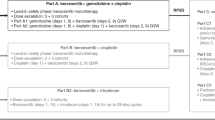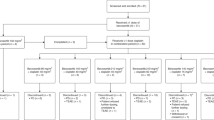Abstract
Purpose
Brostallicin is a DNA minor groove binder which shows enhanced antitumor activity in cells which are resistant to several anticancer agents due to their high glutathione S-transferase (GST)/glutathione content. Phase I and II clinical trials of single-agent brostallicin have shown that myelotoxicity is the dose-limiting toxicity (DLT), while hints of antitumor activity were mainly observed in soft tissue sarcoma. Preclinical studies showing a more than additive antitumor effect of the cisplatin–brostallicin combination paved the way to clinical combination studies. In particular, we set up the first clinical combination study of brostallicin and cisplatin in patients with advanced solid tumors. This study was to be followed by a phase II study in patients with recurrent squamous cell carcinoma of the head and neck (SCCHN).
Methods
Escalating doses of brostallicin were administered in combination with a fixed dose of cisplatin (75 mg/m2) in patients with recurrent or metastatic advanced solid tumors who had previously received a cumulative dose of cisplatin not higher than 475 mg/m2. The recommended dose of brostallicin was expanded in order to have a better estimate of antitumor activity and to better define the safety profile of the combination.
Results
Twenty-one patients were treated. Two DLTs (grade 3 fatigue and febrile neutropenia) were observed at dose level 3 (brostallicin 9 mg/m2). Dose level 2 (brostallicin 7 mg/m2 and cisplatin 75 mg/m2) was recommended for future phase II studies. Main toxicity was hematologic; in fact, only 1 patient out of 21 did not develop neutropenia and only 2 patients did not have thrombocytopenia. Grade 3–4 neutropenia was observed in 90.5% of patients, grade 3–4 thrombocytopenia in 38.1%, grade 3–4 anemia in 23.8%. The cycle 1 nadir (ANC < 500 × 109/L) for neutrophils was Day 14 (median; range 11–17) with recovery to an ANC of >1,500 3.5 days after nadir (median; range 2–4) at dose level 3. The cycle 1 nadir (median of 51,000 × 109/L) for platelets occurred on Day 13 (median; range 10–15) with recovery to a platelet count of >100,000 4 days after nadir (median; range 2–8). No objective responses were observed, but seven patients had a long lasting (>18 weeks) stable disease.
Conclusions
Further studies of the combination of brostallicin and cisplatin are warranted.

Similar content being viewed by others
References
Geroni C, Marchini S, Cozzi P et al (2002) Brostallicin, a novel anticancer agent whose activity is enhanced upon binding to glutathione. Cancer Res 62:2332–2336
Lockhart AC, Howard M, Hande KR et al (2004) A phase I dose-escalation and pharmacokinetic study of brostallicin (PNU-166196A), a novel DNA minor groove binder, in adult patients with advanced solid tumors. Clin Cancer Res 10:468–475
Ten Tije AJ, Verweij J, Sparreboom A et al (2003) Phase I and pharmacokinetic study of brostallicin (PNU-166196), a new DNA minor-groove binder, administered intravenously every 3 weeks to adult patients with metastatic cancer. Clin Cancer Res 9:2957–2964
Sabatino MA, Colombo T, Geroni C, Marchini S, Broggini M (2003) Enhancement of in vivo antitumor activity of classical anticancer agents by combination with the new, glutathione-interacting DNA minor groove-binder, brostallicin. Clin Cancer Res 9:5402–5408
Simon R (1989) Optimal two-stage design for phase II clinical trials. Controll Clin Trials 10:1–10
D’Incalci M, Sessa C (1997) DNA minor groove binding ligands: a new class of anticancer agents. Expert Opin Invest Drugs 6:875–884
Marchini S, Broggini S, Sessa C, D’Incalci M (2001) Development of distamycin-related DNA binding anticancer drugs. Expert Opin Invest Drugs 10:1703–1714
Broggini M, Erba E, Ponti M et al (1991) Selective DNA interaction of the novel distamycin derivative FCE 24517. Cancer Res 51:199–204
Baker B, Dervan PB (1989) Sequence-specific cleavage of DNA by N-bromoacetyldistamycin. Product and kinetic analyses. J Am Chem Soc 111:2700–2712
Sessa C, Pagani O, Zurlo MG et al (1994) Phase I study of the novel distamycin derivative tallimustine (FCE 24517). Ann Oncol 5:901–907
Abigerges D, Armand JP, Da Costa L (1993) Distamycin a derivative, FCE 24517: a phase I study in solid tumors. Proc Am Assoc Cancer Res 34:267
Broggini M, Marchini S, Fontana E et al (2004) A new concept in minor groove DNA binder development. Anticancer Drugs 15:1–6
Fedier A, Fowst C, Tursi J et al (2003) Brostallicin (PNU-166196)—a new DNA minor groove binder that retains sensitivity in DNA mismatch repair-deficient tumours cells. Br J Cancer 89:1559–1565
Kiefer J, Shanmugam K, Weitman S et al (2008) Application of cellular pharmacogenomics and systems biology to identify contexts of vulnerability and guide the clinical development of brostallicin. Proc Am Assoc Cancer Res (abstr 920)
Acknowledgments
Nerviano Medical Sciences (Viale Pasteur, 10-20014 Nerviano, Italy) and Cell Therapeutics, Inc. (501 Elliott Ave., Seattle, WA 98119) are acknowledged for their support.
Author information
Authors and Affiliations
Corresponding author
Rights and permissions
About this article
Cite this article
Caponigro, F., Lorusso, D., Fornari, G. et al. Phase I dose-escalation study of brostallicin, a minor groove binder, in combination with cisplatin in patients with advanced solid tumors. Cancer Chemother Pharmacol 66, 389–394 (2010). https://doi.org/10.1007/s00280-009-1175-6
Received:
Accepted:
Published:
Issue Date:
DOI: https://doi.org/10.1007/s00280-009-1175-6




